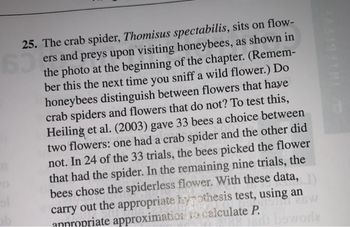
MATLAB: An Introduction with Applications
6th Edition
ISBN: 9781119256830
Author: Amos Gilat
Publisher: John Wiley & Sons Inc
expand_more
expand_more
format_list_bulleted
Question
Pls dont do handwritten and also explain concept and use excel formulas wherever required and not the statistics tables.

Transcribed Image Text:25. The crab spider, Thomisus spectabilis, sits on flow-
63 ers and preys upon visiting honeybees, as shown in
the photo at the beginning of the chapter. (Remem-
ber this the next time you sniff a wild flower.) Do
honeybees distinguish between flowers that have
crab spiders and flowers that do not? To test this,
Heiling et al. (2003) gave 33 bees a choice between
two flowers: one had a crab spider and the other did
not. In 24 of the 33 trials, the bees picked the flower
that had the spider. In the remaining nine trials, the
bees chose the spiderless flower. With these data,
carry out the appropriate hypothesis test, using an
di bowoda
annropriate approximation to calculate P.
il 21
THEEL
Expert Solution
This question has been solved!
Explore an expertly crafted, step-by-step solution for a thorough understanding of key concepts.
This is a popular solution
Trending nowThis is a popular solution!
Step by stepSolved in 3 steps with 14 images

Knowledge Booster
Similar questions
- There is a branch of mathematics that deals with numbers, surveys and the collection of data called statistics. Describe the study of statistics in mathematics. Define the term statistics. Define the term data as it relates to statistics. In statistics there are two types of data, Qualitative data, and Quantitative data. Determine what those terms mean, giving examples to better explain their difference. Given that we are currently studying mathematics we would be examining mostly Quantitative data. In statistics there are two types of Quantitative data, Discrete and Continuous. Define each term, using examples to illustrate the difference between the two. You should already be familiar with the terms Mean, Mode and Median. Those three (3) terms are classed as Measures of Central Tendency. Explain the concept Measures of central tendency. Differentiate among Mean, Mode and Median, giving formulas where relevant. Given the list of numbers, 11, 27, 15, 18, 19, 41, 36, 32 and 24, Find the…arrow_forwardPlease check answers 1; 0.351 2; 0.060 3;0.205 4; 0.172arrow_forwardDescribe about the positively skewed shape of histogram.arrow_forward
- What is ranked data?arrow_forwardThe basketball coach at a local college believes that his team scores more points at home games when more people show up. Below is a list of all home games last year with scores and corresponding attendance. Use Excel, SPSS, or work by hand to show your work finding r. Show your work on the attached pages. Score Attendance Score Attendance 54 380 67 410 57 350 78 215 59 320 67 113 80 478 56 250 82 451 85 450 75 250 101 489 73 489 99 472 53 451 What is the obtained t-score for this correlation? What is the critical t-score for a two-tailed test with a = 0.05? Is this correlation significant based on the t-scores?arrow_forwardDiscuss how statistics, as a way of organizing and summarizing data, helped make good decisions when shoppingarrow_forward
- Does the mean represent the center of the data?arrow_forwardPlease produce descriptive statistics for this data setarrow_forwardThe box plots below show how fast cars are travelling at a specific time of a day on highway I-5 and l-405 in King county. Fill in the blank. I-405 I-5 45 50 55 60 65 70 75 Speed (miles per hour) If Jay is driving at the median speed on l-5, he is driving faster than % of drivers on l-405.arrow_forward
arrow_back_ios
arrow_forward_ios
Recommended textbooks for you
 MATLAB: An Introduction with ApplicationsStatisticsISBN:9781119256830Author:Amos GilatPublisher:John Wiley & Sons Inc
MATLAB: An Introduction with ApplicationsStatisticsISBN:9781119256830Author:Amos GilatPublisher:John Wiley & Sons Inc Probability and Statistics for Engineering and th...StatisticsISBN:9781305251809Author:Jay L. DevorePublisher:Cengage Learning
Probability and Statistics for Engineering and th...StatisticsISBN:9781305251809Author:Jay L. DevorePublisher:Cengage Learning Statistics for The Behavioral Sciences (MindTap C...StatisticsISBN:9781305504912Author:Frederick J Gravetter, Larry B. WallnauPublisher:Cengage Learning
Statistics for The Behavioral Sciences (MindTap C...StatisticsISBN:9781305504912Author:Frederick J Gravetter, Larry B. WallnauPublisher:Cengage Learning Elementary Statistics: Picturing the World (7th E...StatisticsISBN:9780134683416Author:Ron Larson, Betsy FarberPublisher:PEARSON
Elementary Statistics: Picturing the World (7th E...StatisticsISBN:9780134683416Author:Ron Larson, Betsy FarberPublisher:PEARSON The Basic Practice of StatisticsStatisticsISBN:9781319042578Author:David S. Moore, William I. Notz, Michael A. FlignerPublisher:W. H. Freeman
The Basic Practice of StatisticsStatisticsISBN:9781319042578Author:David S. Moore, William I. Notz, Michael A. FlignerPublisher:W. H. Freeman Introduction to the Practice of StatisticsStatisticsISBN:9781319013387Author:David S. Moore, George P. McCabe, Bruce A. CraigPublisher:W. H. Freeman
Introduction to the Practice of StatisticsStatisticsISBN:9781319013387Author:David S. Moore, George P. McCabe, Bruce A. CraigPublisher:W. H. Freeman

MATLAB: An Introduction with Applications
Statistics
ISBN:9781119256830
Author:Amos Gilat
Publisher:John Wiley & Sons Inc

Probability and Statistics for Engineering and th...
Statistics
ISBN:9781305251809
Author:Jay L. Devore
Publisher:Cengage Learning

Statistics for The Behavioral Sciences (MindTap C...
Statistics
ISBN:9781305504912
Author:Frederick J Gravetter, Larry B. Wallnau
Publisher:Cengage Learning

Elementary Statistics: Picturing the World (7th E...
Statistics
ISBN:9780134683416
Author:Ron Larson, Betsy Farber
Publisher:PEARSON

The Basic Practice of Statistics
Statistics
ISBN:9781319042578
Author:David S. Moore, William I. Notz, Michael A. Fligner
Publisher:W. H. Freeman

Introduction to the Practice of Statistics
Statistics
ISBN:9781319013387
Author:David S. Moore, George P. McCabe, Bruce A. Craig
Publisher:W. H. Freeman